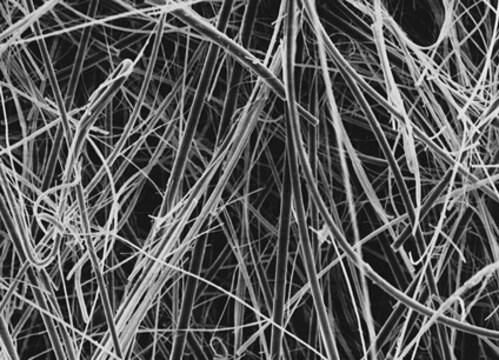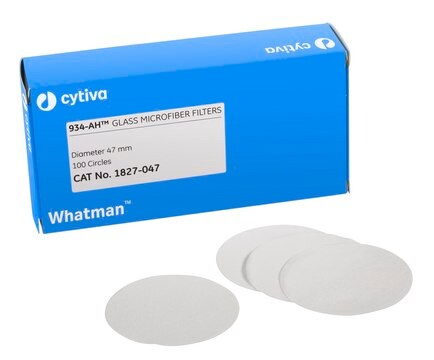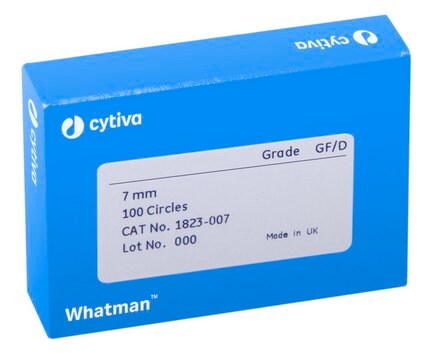APFF12450
Glasfaser-Membranfilter, Porengröße 0,7 μm
Millipore, filter diam. 124 mm, hydrophilic, thickness 380 μm
Synonym(e):
Glass Fiber Filter without binder
About This Item
Empfohlene Produkte
Materialien
glass fiber membrane
plain filter
white filter
Beschreibung
0.7 um pore size, hydrophilic binderless glass fiber, 124 mm diameter
Leistungsmerkmale
hydrophilic
Hersteller/Markenname
Millipore
Parameter
1.4 mL/min-cm2 water flow rate
500 °C max. temp.
Filterdurchm.
124 mm
Dicke
380 μm
Porengröße
0.7 μm pore size
Versandbedingung
ambient
Suchen Sie nach ähnlichen Produkten? Aufrufen Leitfaden zum Produktvergleich
Allgemeine Beschreibung
Millipore fibrous disc filters are available in a wide range of flow rates and throughput capacities. Our Glass Fiber filters are available with or without binder resins and can be sterilized by EO, gamma, or autoclave (121 °C at 1 bar).
Glass Fiber Filters with Binder Resin:
Millipore filters with binder resin have superior wet strength and are excellent for qualitative analysis and prefiltration, especially for heavily contaminated liquids. They are also widely used for clarification of aqueous solutions.
Type AP15
•Lowest dirt-holding capacity
•Recommended prefilter for 0.2 to 0.6 µm filters
Type AP20
•Lower retention, higher dirt-holding capacity than AP15 filters
•Recommended prefilter for 0.8 to 8.0 µm filters
•Use upstream to protect type AP15 filters
Type AP25
•Added thickness yields same retention and greater dirt-holding capacity as AP20
•Recommended prefilter for 0.9 to 8 µm filters, especially for proteinaceous and heavily contaminated liquids
•Use upstream to protect type AP15 filters
Glass Fiber Filters without Binder Resin:
The filters without binder resin retain their structural integrity without weight loss when heated up to 500 °C and can therefore be used in gravimetric analysis as well as for the filtration of hot gases.
Type APFA
•Retains fine particles with good efficiency, even at high flow rates
•Recommended for monitoring wastewater and collecting suspended particles in gases (e.g., fumes from chimneys)
•Use in biochemical applications (e.g., collection of cells and filtration of protein or nucleic acid precipitates)
Type APFB
•Higher mechanical strength when wet and greater loading capacity than type APFA filters
•Use for liquid clarification, quantification of solids in suspensions of fine particles, and scintillation counting
Type APFC
•Greater retention, especially for fine particulate and microorganism removal than type APFA filters
•Use for determining total suspended solids in drinking water
•Use for filtering proteins or nucleic acid TCA precipitates and for collecting cells and microorganisms
Type APFD
•Thick filter with high flow and low retention
•Use for clarifying suspensions containing particulates greater than 1.0 µm
Type APFF
•Use for filtering extremely fine precipitates such as protein, nucleic acids, or serum precipitates
•Recommended for USEPA method 1311 for TCLP analysis
Type AP40
•Recommended for Standard Methods Total Suspended Solids 2540D
•Recommended for USEPA method 1311 for TCLP analysis
•Maintains structural integrity without weight loss when ignited to 550 °C (1022 °F) after sample filtration
•Recommended for determining volatile suspended matter in wastewater and industrial effluents
Anwendung
- Filtering extremely fine precipitates
- Filtration of protein, nucleic acids, or serum precipitates
- EPA method 1311 for TCLP analysis
- Microplastics analysis grade water
Sonstige Hinweise
- Organism Retention: Microorganism
- Mode of Action: Filtration (size exclusion)
- Application: General laboratory filtration
- Intended Use: Retention or removal of biological contaminants
- Instructions for Use: Sterilizing filtration of a liquid through a membrane with a 0.2 μm (or smaller) pore size effectively removes biological contaminants, including bacteria, mold and yeast. For the selective retention of larger biological contaminents, liquid filtration through membranes with 0.45 μm (or larger) pore sizes may be used to trap and support microorganism growth for subsequent culture and analysis
- Storage Statement: Store in dry location
- Disposal Statement: Dispose of in accordance with applicable federal, state and local regulations.
Lagerklassenschlüssel
10-13 - German Storage Class 10 to 13
Analysenzertifikate (COA)
Suchen Sie nach Analysenzertifikate (COA), indem Sie die Lot-/Chargennummer des Produkts eingeben. Lot- und Chargennummern sind auf dem Produktetikett hinter den Wörtern ‘Lot’ oder ‘Batch’ (Lot oder Charge) zu finden.
Besitzen Sie dieses Produkt bereits?
In der Dokumentenbibliothek finden Sie die Dokumentation zu den Produkten, die Sie kürzlich erworben haben.
Unser Team von Wissenschaftlern verfügt über Erfahrung in allen Forschungsbereichen einschließlich Life Science, Materialwissenschaften, chemischer Synthese, Chromatographie, Analytik und vielen mehr..
Setzen Sie sich mit dem technischen Dienst in Verbindung.




